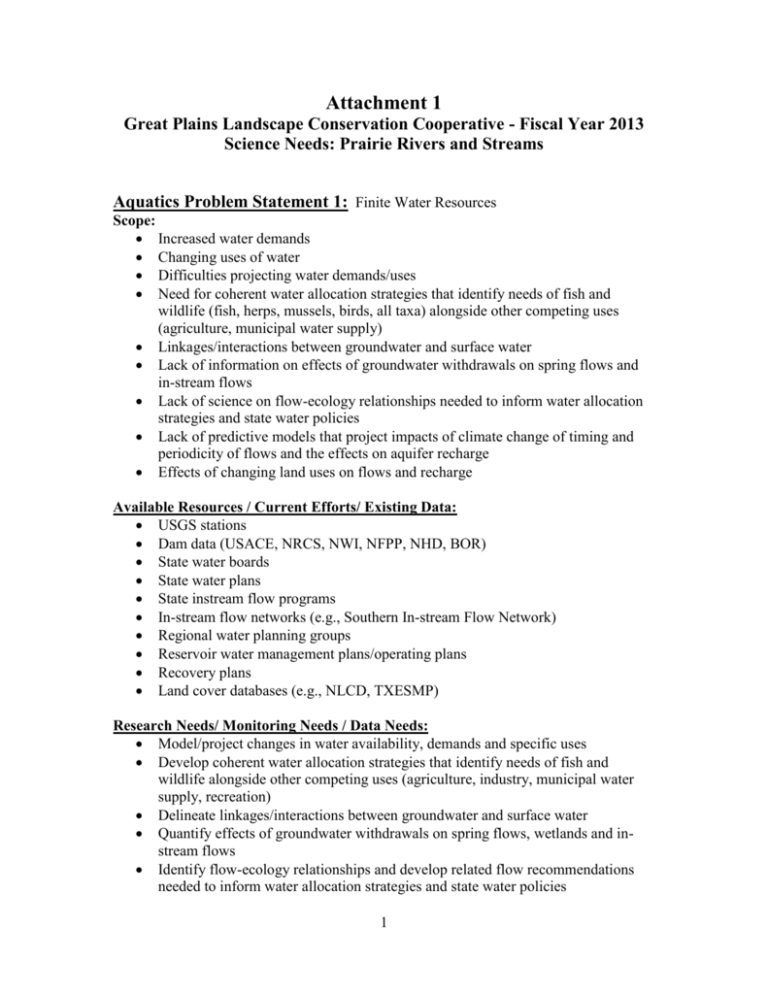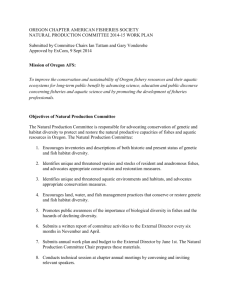Full-Announcement-Attachment-_1
advertisement

Attachment 1 Great Plains Landscape Conservation Cooperative - Fiscal Year 2013 Science Needs: Prairie Rivers and Streams Aquatics Problem Statement 1: Finite Water Resources Scope: Increased water demands Changing uses of water Difficulties projecting water demands/uses Need for coherent water allocation strategies that identify needs of fish and wildlife (fish, herps, mussels, birds, all taxa) alongside other competing uses (agriculture, municipal water supply) Linkages/interactions between groundwater and surface water Lack of information on effects of groundwater withdrawals on spring flows and in-stream flows Lack of science on flow-ecology relationships needed to inform water allocation strategies and state water policies Lack of predictive models that project impacts of climate change of timing and periodicity of flows and the effects on aquifer recharge Effects of changing land uses on flows and recharge Available Resources / Current Efforts/ Existing Data: USGS stations Dam data (USACE, NRCS, NWI, NFPP, NHD, BOR) State water boards State water plans State instream flow programs In-stream flow networks (e.g., Southern In-stream Flow Network) Regional water planning groups Reservoir water management plans/operating plans Recovery plans Land cover databases (e.g., NLCD, TXESMP) Research Needs/ Monitoring Needs / Data Needs: Model/project changes in water availability, demands and specific uses Develop coherent water allocation strategies that identify needs of fish and wildlife alongside other competing uses (agriculture, industry, municipal water supply, recreation) Delineate linkages/interactions between groundwater and surface water Quantify effects of groundwater withdrawals on spring flows, wetlands and instream flows Identify flow-ecology relationships and develop related flow recommendations needed to inform water allocation strategies and state water policies 1 Develop predictive models that project effects of climate change on aquifer recharge, spring flows, and timing and periodicity of flows Determine effects of changing land uses on aquifer recharge, spring flows, wetland persistence and in-stream flows Develop spatial/temporal flow allocation strategies that support natural flow regimes Identification of physical, biological, and ecological targets influenced by natural flow regimes (e.g., maintenance of sand bars, life history needs) Human dimensions research focused on human perceptions and viability of specific water allocation and water conservation strategies Experimental manipulation of in situ flow releases (e.g., flow pulses) and other conservation demonstration projects that support the development of BMPs Finer resolution land cover datasets (e.g., updated NWI, NLCD, etc.) Strategy to Achieve Results: Develop partner networks to support project planning, design and implementation Develop MOUs, cooperative agreements or other mechanisms to ensure long-term support and participation of partners Develop targeted RFPs Develop tools and policies that support data/information sharing, data management, and product development Identify mechanisms to engage key stakeholders as needed (e.g., river authorities, industry) Anticipated Products/ Tools/ Assessments: Flow allocation strategies that address competing demands, and that support natural flow regimes/physical processes and spp life history needs Applicability to Resource Management: Science-based recommendations that support the management of available water resources to meet biological/ecological targets Potential Role(s) for Partners of the GPLCC: Better engage and inform the GPLCC Steering Committee and other key stakeholders on the importance of aquatic resource conservation issues in the Great Plains Develop partner networks to support project planning, design and implementation Develop MOUs, cooperative agreements or other mechanisms to ensure long-term support and participation of partners Develop targeted RFPs Develop tools and policies that support data/information sharing, data management, and product development Identify mechanisms to engage key stakeholders as needed (e.g., river authorities, industry) 2 Aquatics Problem Statement 2: Alteration and Fragmentation of Watersheds and Physical Aquatic Habitats Scope: Current and changing land uses, habitat alteration and effects on aquatic habitats and ecosystems Watershed and in-stream connectivity (e.g., barriers to movement/reproductive success, effects on flow, etc.) Disruption or changes in nutrient inputs, cycling and food web dynamics (e.g., linkages between riparian zones and terrestrial inputs into aquatic food webs) Changes in sediment transport and maintenance of fluvial processes (from landscape alteration, dams, changes in timing and periodicity of flows, etc.) Riparian invasives and their effects on structural habitats and fluvial processes (salt cedar, giant reed, purple loosestrife, etc.) Wetland degradation or loss (e.g., draining of wetlands, loss of spring flows that sustain wetlands) Terrestrial habitat degradation and effects on aquifer and spring recharge Watershed alteration (e.g., construction of small dams and their effects on overland runoff, wetland persistence and in-stream flows) Available Resources / Current Efforts/ Existing Data: USGS stations Dam data (USACE, NRCS, NWI, NFPP, NHD) Recovery plans NHD Land cover datasets (although limited) National Fish Habitat Assessment National, regional and state stream survey programs (e.g., NRSA) Research Needs/ Monitoring Needs / Data Needs: Evaluate habitat alteration and effects on species abundance and composition Evaluate watershed connectivity and effects on aquatic ecosystems (e.g., barriers to movement, effects on flow, etc.) Evaluate effects of landscape-scale changes to habitats on fulfillment of life history needs of aquatic species Assess changes in habitats and effects on nutrient inputs, cycling and food web dynamics (e.g., linkages between riparian zones and terrestrial inputs into aquatic food webs) Evaluate changes in sediment transport and fluvial processes on abundance and diversity of aquatic habitats and community composition Monitor and evaluate the distribution and effects of riparian invasives on structural habitats and fluvial processes (e.g., salt cedar, giant reed, purple loosestrife, etc.) Effects of habitat management actions (e.g., chemical treatments) on food webs and non-target species (plants and animals) 3 Development of recovery/conservation plans for species of concern (e.g., federal or state listed, SWAP Species of Greatest Conservation Need) Strategy to Achieve Results: Develop partner networks to support project planning, design and implementation Develop MOUs, cooperative agreements or other mechanisms to ensure long-term support and participation of partners Develop targeted RFPs Develop tools and policies that support data/information sharing, data management, and product development Identify mechanisms to engage key stakeholders as needed (e.g., river authorities, industry) Anticipated Products/ Tools/ Assessments: Assessment of current condition and trends for aquatic habitats. Strategies, best management practices and decision support tools for the restoration, preservation and enhancement of aquatic habitats. Applicability to Resource Management: Science-based priorities and approaches for aquatic habitat conservation. Potential Role(s) for Partners of the GPLCC: Develop partner networks to support project planning, design and implementation Develop MOUs, cooperative agreements or other mechanisms to ensure long-term support and participation of partners Develop targeted RFPs Develop tools and policies that support data/information sharing, data management, and product development Identify mechanisms to engage key stakeholders as needed (e.g., river authorities, industry) 4 Aquatics Problem Statement 3: Lack of Current Data and Information on the Status and Trends of Species and Their Habitats Scope: Lack of basic life history information for aquatic species Lack of standardized surveys Lack of range-wide data and information for focal species Lack of long-term monitoring data to understand trends Lack of a consistent data management, data policies or data access Available Resources / Current Efforts/ Existing Data: Recovery/conservation plans National Fish Habitat Assessment National, regional and state stream survey programs (e.g., NRSA) Natureserve Research Needs/ Monitoring Needs / Data Needs: Range-wide assessments of focal species and their habitats Identification of indicator species Collection of long-term monitoring data to understand trends Development of species distribution models Identification of basic life history information for aquatic species needed to manage species and their habitats Development and implementation of standardized surveys Development of consistent data management procedures, data policies and data access Strategy to Achieve Results: Develop partner networks to support project planning, design and implementation Develop MOUs, cooperative agreements or other mechanisms to ensure long-term support and participation of partners Develop targeted RFPs Develop tools and policies that support data/information sharing, data management, and product development Identify mechanisms to engage key stakeholders as needed (e.g., river authorities, industry) Anticipated Products/ Tools/ Assessments: Assessment of current condition and trends for aquatic species and their habitats Predictive tools that project impacts of anticipated changes to the landscape (e.g., urbanization, rainfall patterns, etc.) on aquatic species and their habitats Species response to landscape changes Database of life history traits to support applied management of species and their habitats 5 Strategies, best management practices and decision support tools for species restoration and conservation Applicability to Resource Management: Science-based approaches and priorities for the restoration and conservation of focal species and their habitats. Potential Role(s) for Partners of the GPLCC: Develop partner networks to support project planning, design and implementation Develop MOUs, cooperative agreements or other mechanisms to ensure long-term support and participation of partners Develop targeted RFPs Develop tools and policies that support data/information sharing, data management, and product development Identify mechanisms to engage key stakeholders as needed (e.g., river authorities, industry) 6







